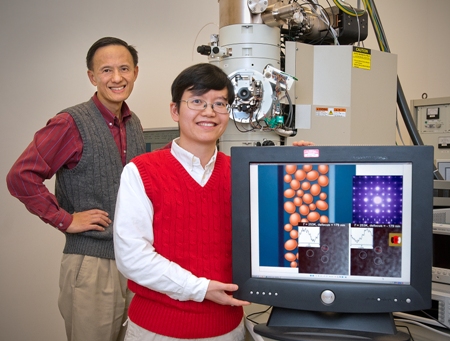Scientists at the Universidad San Francisco de Quito in Ecuador and the Brookhaven National Laboratory of the U.S. Department of Energy have discovered that nanoclusters form in some oxide materials at certain temperatures as well as increase the electrical current flow in the materials.
 Lead author Jing Tao (right) with Group Leader Yimei Zhu show their findings in front of the transmission electron microscope used to identify nanoclusters forming at particular temperatures in a magnetic field that are essential to the emergence of colossal magnetoresistance.
Lead author Jing Tao (right) with Group Leader Yimei Zhu show their findings in front of the transmission electron microscope used to identify nanoclusters forming at particular temperatures in a magnetic field that are essential to the emergence of colossal magnetoresistance.
These findings are helpful in developing several industrial applications such as spintronics wherein magnetic and electrical properties are utilized for solid-state electronics. Certain oxide materials demonstrate colossal magnetoresistance, a phenomenon that describes the change in electric current flow in materials in the presence of a magnetic field.
The researchers used the oxides having atoms arranged in a unique pattern. During the study, the researchers have discovered that nanoclusters having a 10-atom size have formed in the oxides when a magnetic field is applied at specific temperatures. These nanoclusters have demonstrated different electronics properties when compared to that of the oxides and are critical for demonstrating colossal magnetoresistance phenomenon. According to the research findings, the magnetic properties of the nanoclusters vary with temperature. The nanoclusters turn into ferromagnetic and conductive at a specific temperature under a magnetic field, thus enabling the occurrence of the colossal magnetoresistance phenomenon.
For the study, the researchers at the Universidad San Francisco de Quito in Ecuador developed manganite crystals. Manganite is a manganese oxide material doped with different amounts of lanthanum, a rare-earth metal, and calcium. The Brookhaven National Laboratory utilized its transmission electron microscope to analyze the properties of the crystal by bombarding negatively charged, high-powered electron beams. The lab studied the energy levels and paths of the electrons during their passage through the manganite crystals in order to identify properties such as magnetism and structure, as well as the role of nanoclusters in the appearance of colossal magnetoresistance.
Source: http://www.bnl.gov